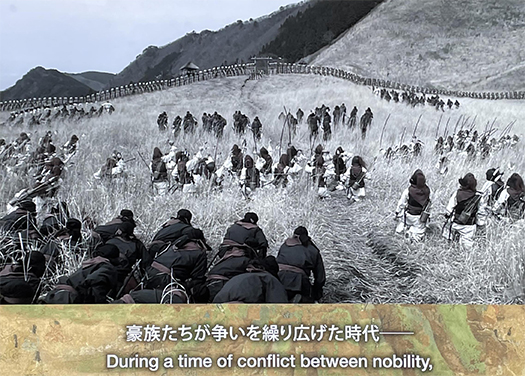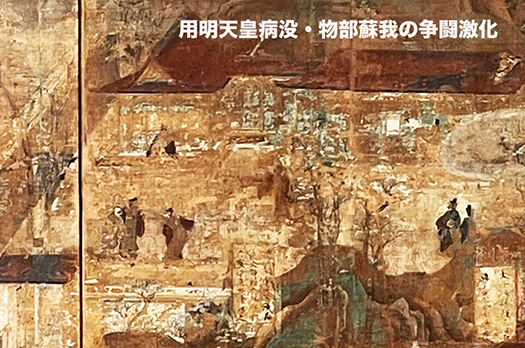


「法隆寺宝物館「聖徳太子絵伝」についての記事、第6回目の今回は、587年、聖徳太子16才の時に勃発した仏教導入を進める「崇仏派」と、それに反発する「排仏派」と呼ばれた勢力との戦い「丁未の乱」。
このシリーズの第一回はこちら→端正なモダニズム「法隆寺宝物館」探訪。
当時の朝廷内では蘇我氏と物部氏がそれぞれの立場の頭目だった。蘇我氏を外戚に持つ時の天皇・用明は崇仏派であり仏法を重んじ王朝において仏教を実質公認した。一方、危機感を持った廃仏派の筆頭である物部守屋は、欽明天皇の皇子の一人の穴穂部皇子と通じていた。用明天皇は天然痘のため在位2年足らずの587年4月9日(古事記では4月15日)に崩御した。権力の真空状況が生まれた瞬間にこの武力衝突は起こった。
用明帝崩御から3ヶ月後の587年7月、蘇我馬子は物部守屋追討軍を派遣し厩戸皇子(聖徳太子)などの皇族や諸豪族の軍兵を率いて河内国渋川郡の守屋の館へ進軍。大和国から河内国へ入った蘇我軍は餌香川の河原で物部軍と交戦し、戦後の河内国司の言によれば双方合わせての戦死者は数百に上った。
この激戦の中、厩戸皇子は仏法の加護を得ようと四天王像をつくり、戦勝を祈願し勝利すれば仏塔をつくり仏法の普及に努めると誓った。激戦の中、守屋は矢に当たって死亡し総大将を失った物部軍は総崩れ。この好機に追討軍の寄せ手は攻めかかり守屋の一族を皆殺しにした。
蘇我氏勢力は親子2代にわたって対立してきた宿敵・物部氏の勢力を中央から完全に排除することに成功し、厩戸皇子と連携してさらに権勢を強めていく。物部氏を中心とした仏教反対派の発言力が衰え、仏教の国内浸透も本格化した。戦後厩戸皇子は摂津国に四天王寺を建立した。<以上、Wiki記述から要旨抜粋>

いちばん上の映像はデジタル聖徳太子絵伝展で公開されていたビジュアル画像。多数のエキストラを動員し野外ロケも行っていた様子。あるいはテレビ番組制作などの機会に撮影されたものを法隆寺宝物館が利用していたのかも知れない。正面に見える柵が物部氏勢力のもので手前側が蘇我氏側。現代で考えられている時代考証を踏まえての各種設定だろうと思える。
聖徳太子はこの戦いに参陣しているのでまさに生々しい。それこそ聖人君子とて「覇道」を持って権力闘争を勝ち取った状況が見て取れる。この世はきれい事ではないのだ。物部守屋の領地は戦後、蘇我氏と四天王寺に両分されたといわれている。現在にまで残る四天王寺の伽藍の初源の様子が描かれている。
こうしていろいろな研究者の整理分析に基づいて聖徳太子絵伝をじっくりと解析していくと、太子の生きた時代(572〜622年)や絵伝成立時代(平安後期・1069年)の空気感が再生されてくる。聖徳太子絵伝によって、これまで知ることのなかった時代に気付かされその吸引力に強く惹かれている(笑)。・・・
English version⬇
Prayer to Prince Shotoku’s Four Heavenly Kings Victory in the Civil War of the Chōbutsu Faction The Gallery of Horyu-ji Treasures-6
The “Dingmi Rebellion,” an armed struggle within the regime that I did not know much about. A civil war during the period of the introduction of Buddhism. At the boiling point of the times, bloody battles decided the fate of the nation. …
In this sixth installment of the series of articles on “Shotoku Taishi Eiden” in the Gallery of Horyuji Treasures, we will look at the “Chomi no Rebellion” that broke out in 587, when Shotoku Taishi was 16 years old, between the “Chobutsuha” who promoted the introduction of Buddhism and the “Chobutsuha” who opposed the introduction.
Click here for the first article in this series→Exploring the neat modernism of the “Gallery of Horyuji Treasures.→端正なモダニズム「法隆寺宝物館」探訪。
The Soga and Monobe clans were the heads of their respective positions within the Imperial Court at that time. Emperor Yomei, who had the Soga clan as his relatives, was of the Buddhist sect and respected Buddhism. On the other hand, Monobe no Moriya, who was the leader of the abolitionist faction, had a sense of crisis and was in communication with Prince Anahobe, one of Emperor Kinmei’s princes. Emperor Yomei collapsed on April 9, 587 (April 15 in the Kojiki), less than two years into his reign, due to smallpox. This armed conflict occurred at the moment a power vacuum was created.
In July 587, three months after the fall of Emperor Yomei, Soga Umako dispatched an army to pursue Monobe Moriya, and led a military force of the imperial family, including Prince Umamado (Prince Shotoku), and various powerful families to march on Moriya’s mansion in Shibukawa-gun, Kawachi Province. The Soga army entered Kawachi Province from Yamato Province and engaged Monobe’s army on the banks of the Yakka River, and according to the Kawachi provincial governor after the war, the combined death toll on both sides was several hundred.
In the midst of this fierce battle, Prince Umayato made statues of the Four Heavenly Kings to pray for victory and to obtain the blessings of Buddhism, and vowed that if he won the battle, he would build a pagoda and work to spread Buddhism. In the fierce battle, Moriya was hit by an arrow and killed, and Monobe’s army, which had lost its general, was crushed. Taking advantage of this opportunity, the pursuing force attacked and killed all of Moriya’s family members.
The Soga clan succeeded in completely eliminating the power of their archrival Mononobe clan, which had been at odds with the Soga clan for two generations, from the center of the country, and further strengthened their power in cooperation with Emperor Umato-no-mikoto. The Mononobe clan and other opponents of Buddhism waned in power, and the penetration of Buddhism into the country began in earnest. After the war, Prince Umayato built Shitennoji Temple in Settsu Province.

The top image is a visual image that was shown at the Digital Shotoku Taishi Eiden exhibition. It appears that a large number of extras were mobilized and outdoor filming was conducted. The image may have been filmed for a TV program, and then used by the Gallery of Horyuji Treasures. The fence in the front is for the Mononobe clan, and the one in the foreground is for the Soga clan. It seems likely that the various settings were made based on the historical research considered in the present day.
Prince Shotoku was present at this battle, so it is very vivid. We can see how even a saintly prince won the power struggle with his “high road”. This world is not a pretty one. It is said that after the war, Monobe Moriya’s domain was divided between the Soga clan and Shitennoji. The first source of the Shitennoji temple complex, which remains to this day, is depicted.
When the pictorial biography of Shotoku Taishi is carefully analyzed based on the organized analysis of various researchers, the atmosphere of the period in which Taishi lived (572-622) and the period in which the pictorial biography was established (late Heian period, 1069) can be reproduced. The pictorial biography of Shotoku Taishi makes me aware of an era that I had never known before, and I am strongly attracted to its attractiveness (laugh). Laughs.
Posted on 6月 3rd, 2023 by 三木 奎吾
Filed under: 歴史探訪







コメントを投稿
「※誹謗中傷や、悪意のある書き込み、営利目的などのコメントを防ぐために、投稿された全てのコメントは一時的に保留されますのでご了承ください。」
You must be logged in to post a comment.